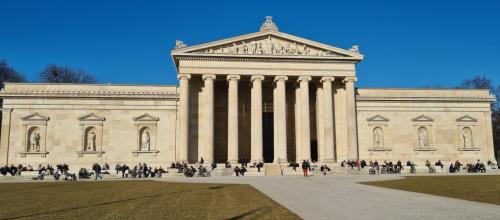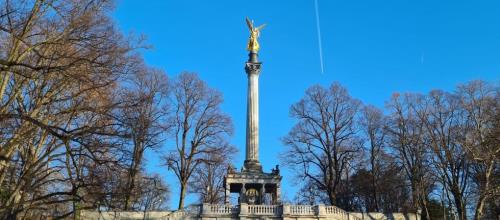München als Kunststadt

München wird als Stadt der Kunst dargestellt und von einer der Figuren sogar als „Art-City“ (Margaret von Ehrenberg, the Artist-Wife, S. 56) bezeichnet. Zu Beginn der Geschichte besucht der Baron eine Ausstellung:
This week there were sketches by Genelli, exquisite etchings after Richter of Dresden, a portrait of a celebrated poet by Kaulbach, a study by Schnorr for a new cartoon, and more than the usual display of pleasant genre pictures and fresh joyous Tyrolean landscapes. It really was an unusually rich exhibition.
(Margaret von Ehrenberg, the Artist-Wife, S. 2)
Dort trifft er auf König Ludwig I., der aufgrund seines Engagements für die Künste in München als „his poetic and artistic Majesty, King Ludwig of Bavaria“ (Margaret von Ehrenberg, the Artist-Wife, S. 4) bezeichnet wird und in der Galerie die Gemälde von Margaret von Ehrenberg bewundert. Auch die auf seine Anweisung hin errichtete Glyptothek wird beschrieben:
Above the clustering acacias, lilac, and laburnums of the garden, were seen the pure white marble columns and pediment of the beautiful Glyptothek, the gallery of sculpture, the evening sunlight gleaming upon its loveliness, and tinting the one side with roseate reflections, whilst the other remained in azure shadow, and beyond all, along the vast mournful horizon, lay a solemn assembly of gorgeous evening clouds, golden, rose, violet, dun, with heavenly glory streaming through them in mighty rays of fiery light.
(Margaret von Ehrenberg, S. 30)
Margarets Einbindung in die Münchner Kunstszene ermöglicht die Erwähnung zweier weiterer historischer Persönlichkeiten:
The studios of Kaulbach and Schwanthaler were visited, and the fresh worlds of thought opened […] by the deeply philosophic art of Kaulbach and by the quaint and wildly poetical creations of Schwanthaler led to spirit-stirring discussions […]. The rich collections of statuary and painting contained in the Glyptothek and Pinakothek, and the lovely modern churches erected by the poet king Ludwig, were duly visited and rejoiced in.
(Margaret von Ehrenberg, S. 64)
München scheint auch für angehende Künstler*innen ein relevanter Standort zu sein. Ein Polizist erzählt der Protagonistin, dass er seinen Sohn gerne auf die ‚Academy of Painting‘ (vermutlich die Akademie der Bildenden Künste) schicken möchte und erhält von ihr Arbeitsmaterial für seinen Sohn. Am Ende der Novelle dann zeigt Margaret ihrer jungen Verwandten Signild die Kunststudios in München und hilft damit, eine neue Generation von Künstler*innen heranzuziehen.
Margaret wird in der Novelle mit dem Friedensengel verglichen.
Weitere Kapitel:

München wird als Stadt der Kunst dargestellt und von einer der Figuren sogar als „Art-City“ (Margaret von Ehrenberg, the Artist-Wife, S. 56) bezeichnet. Zu Beginn der Geschichte besucht der Baron eine Ausstellung:
This week there were sketches by Genelli, exquisite etchings after Richter of Dresden, a portrait of a celebrated poet by Kaulbach, a study by Schnorr for a new cartoon, and more than the usual display of pleasant genre pictures and fresh joyous Tyrolean landscapes. It really was an unusually rich exhibition.
(Margaret von Ehrenberg, the Artist-Wife, S. 2)
Dort trifft er auf König Ludwig I., der aufgrund seines Engagements für die Künste in München als „his poetic and artistic Majesty, King Ludwig of Bavaria“ (Margaret von Ehrenberg, the Artist-Wife, S. 4) bezeichnet wird und in der Galerie die Gemälde von Margaret von Ehrenberg bewundert. Auch die auf seine Anweisung hin errichtete Glyptothek wird beschrieben:
Above the clustering acacias, lilac, and laburnums of the garden, were seen the pure white marble columns and pediment of the beautiful Glyptothek, the gallery of sculpture, the evening sunlight gleaming upon its loveliness, and tinting the one side with roseate reflections, whilst the other remained in azure shadow, and beyond all, along the vast mournful horizon, lay a solemn assembly of gorgeous evening clouds, golden, rose, violet, dun, with heavenly glory streaming through them in mighty rays of fiery light.
(Margaret von Ehrenberg, S. 30)
Margarets Einbindung in die Münchner Kunstszene ermöglicht die Erwähnung zweier weiterer historischer Persönlichkeiten:
The studios of Kaulbach and Schwanthaler were visited, and the fresh worlds of thought opened […] by the deeply philosophic art of Kaulbach and by the quaint and wildly poetical creations of Schwanthaler led to spirit-stirring discussions […]. The rich collections of statuary and painting contained in the Glyptothek and Pinakothek, and the lovely modern churches erected by the poet king Ludwig, were duly visited and rejoiced in.
(Margaret von Ehrenberg, S. 64)
München scheint auch für angehende Künstler*innen ein relevanter Standort zu sein. Ein Polizist erzählt der Protagonistin, dass er seinen Sohn gerne auf die ‚Academy of Painting‘ (vermutlich die Akademie der Bildenden Künste) schicken möchte und erhält von ihr Arbeitsmaterial für seinen Sohn. Am Ende der Novelle dann zeigt Margaret ihrer jungen Verwandten Signild die Kunststudios in München und hilft damit, eine neue Generation von Künstler*innen heranzuziehen.
Margaret wird in der Novelle mit dem Friedensengel verglichen.

